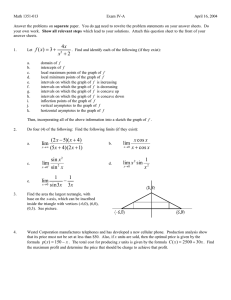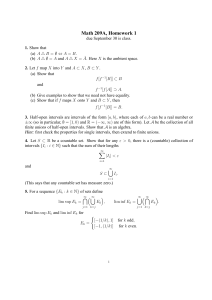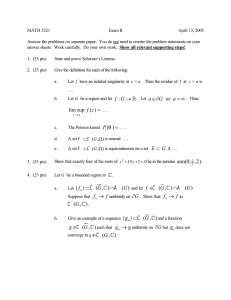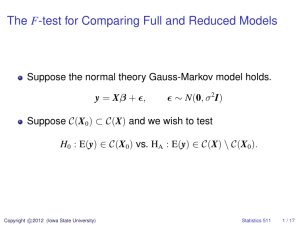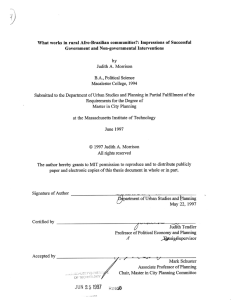Georgian Mathematical Journal 1(94), No. 5, 469-478 DENJOY INTEGRAL
advertisement
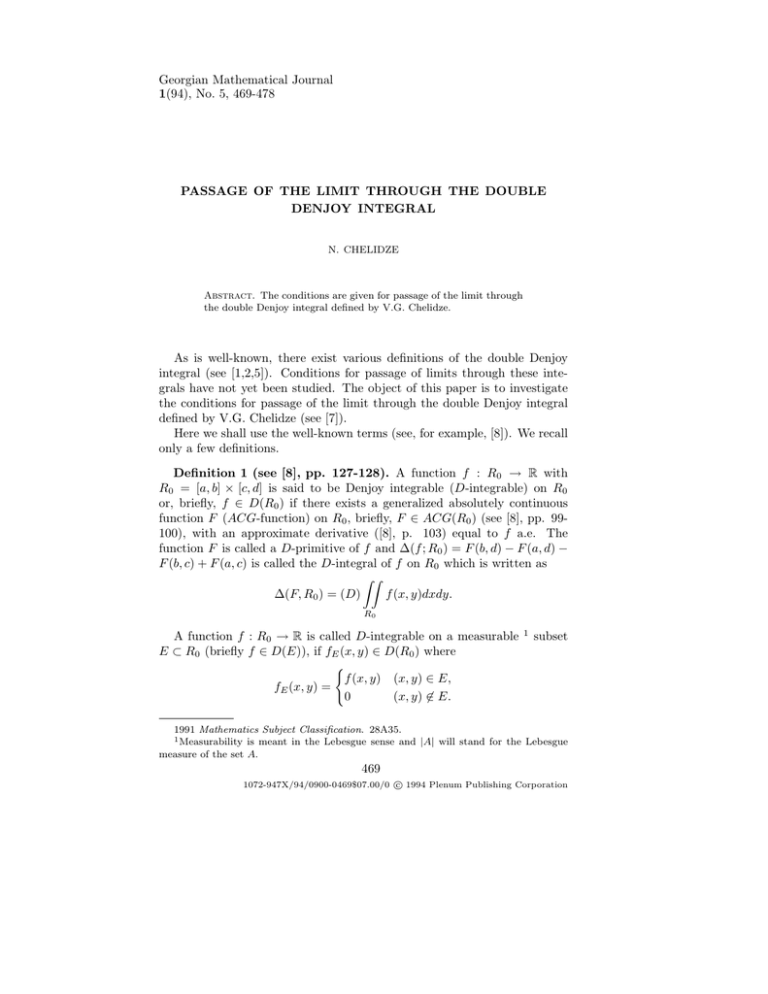
Georgian Mathematical Journal
1(94), No. 5, 469-478
PASSAGE OF THE LIMIT THROUGH THE DOUBLE
DENJOY INTEGRAL
N. CHELIDZE
Abstract. The conditions are given for passage of the limit through
the double Denjoy integral defined by V.G. Chelidze.
As is well-known, there exist various definitions of the double Denjoy
integral (see [1,2,5]). Conditions for passage of limits through these integrals have not yet been studied. The object of this paper is to investigate
the conditions for passage of the limit through the double Denjoy integral
defined by V.G. Chelidze (see [7]).
Here we shall use the well-known terms (see, for example, [8]). We recall
only a few definitions.
Definition 1 (see [8], pp. 127-128). A function f : R0 → R with
R0 = [a, b] × [c, d] is said to be Denjoy integrable (D-integrable) on R0
or, briefly, f ∈ D(R0 ) if there exists a generalized absolutely continuous
function F (ACG-function) on R0 , briefly, F ∈ ACG(R0 ) (see [8], pp. 99100), with an approximate derivative ([8], p. 103) equal to f a.e. The
function F is called a D-primitive of f and ∆(f ; R0 ) = F (b, d) − F (a, d) −
F (b, c) + F (a, c) is called the D-integral of f on R0 which is written as
ZZ
∆(F, R0 ) = (D)
f (x, y)dxdy.
R0
A function f : R0 → R is called D-integrable on a measurable
E ⊂ R0 (briefly f ∈ D(E)), if fE (x, y) ∈ D(R0 ) where
(
f (x, y) (x, y) ∈ E,
fE (x, y) =
0
(x, y) 6∈ E.
1
subset
1991 Mathematics Subject Classification. 28A35.
1 Measurability is meant in the Lebesgue sense and |A| will stand for the Lebesgue
measure of the set A.
469
c 1994 Plenum Publishing Corporation
1072-947X/94/0900-0469$07.00/0
470
N. CHELIDZE
Definition 2. A compact interval I is said to be of type 2 with respect
to E if at least one pair of the opposite vertices of I lies in E.
Lemma 1. Let E1 be a compact subset of [a, b] whose contiguous intervals are {ri }i . If f ∈ D(E), f ∈ D(R̄i ), i = 1, ∞, where E = E1 × [c, d],
Ri = ri × [c, d], and
∞
X
i=1
where
(1)
O(D; f, R̄i ) < ∞,
ZZ
o
n
O[D; f, R̄i ] = sup (D)
f (t, τ )dt dτ
ρ⊂R̄i
ρ
and ρ stands for any measurable subset of R̄i . Then f ∈ D(R0 ) and for
each subsegment R ⊂ R0 we have
ZZ
ZZ
X ZZ
(D)
f (t, τ )dt dτ = (D)
f (t, τ )dt dτ +
f (t, τ )dt dτ.
R
i
R∩E
R∩R̄i
Proof. Let us consider the function
ZZ
X
(D)
F (x, y) =
i
f (t, τ )dt dτ,
R̄i ∩I(x,y)
where I(x, y) = [a, x; c, y].
We shall show that F is continuous on R0 , i.e., F is continuous at any
point (x0 , y0 ) of R0 ; for ε > 0 there must exist a δ(ε) > 0 such that the
inequality |F (x0 + k, y0 + l) − F (x0 , y0 )| < ε. must take place for all k and
l, |k| < δ(ε), |l| < δ(ε). Then
ZZ
X
F (x0 + k, y0 + l)−F (x0 , y0 ) =
f (t, τ )dt dτ −
(D)
−
X
i
(D)
ZZ
R̄i ∩I(x0 +k,y0 +l)
i
R̄i ∩I(x0 ,y0 )
ZZ
X
f (t, τ )dt dτ ≤
(D)
i
R̄i ∩Px0 ,y0
f (t, τ )dt dτ ,
where Px0 ,y0 = [a, x0 ; y0 , y0 + l] ∪ [x0 , x0 + k; c, y0 + l].
To estimate the last sum let us consider two subsystems of intervals from
the system {Ri }i=1,∞ : I 0 = {Ri0 } and I 00 = {Ri00 } such that system I 0
satisfies the conditions:
R̄i0 ∩ Px0 ,y0 6= ∅ and i > N
00
and system I the conditions
R̄i00 ∩ Px0 ,y0 =
6 ∅ and i ≤ N .
PASSAGE OF THE LIMIT THROUGH THE DENJOY INTEGRAL
471
For the first system for all ε > 0 there is an N0 = N0 (ε) such that if
N > N0 , then by the condition (1) we get the estimate
ZZ
X
(D)
i>N
R̄i0 ∩Px0 ,y0
X
ε
O[D; f, R̄i0 ] < .
f (t, τ )dt dτ <
2
i>N
Now consider system I 00 . Since i ≤ N , this system is finite. Let N ∗ be
the number of members of this system. Then for ε > 0 there is a δ(ε) > 0
such that |Px0 ,y0 | < δ and |Px0 ,y0 ∩ R̄i00 | < |Px0 ,y0 | < δ. Hence it follows
(D)
ZZ
ε
.
2N ∗
f (t, τ )dt dτ <
R̄i00 ∩Px0 ,y0
Now
ZZ
X
(D)
i≤N
R̄i00 ∩Px0 ,y0
Finally, we obtain
f (t, τ )dt dτ ≤
|F (x0 + k, y0 + l) − F (x0 , y0 )| ≤
ZZ
X
=
(D)
i>N
ε
ε
· N∗ = .
2N ∗
2
ZZ
X
(D)
R̄i ∩Px0 ,y0
i
ZZ
X
f (t, τ )dt dτ +
(D)
R̄i0 ∩Px0 ,y0
i≤N
f (t, τ )dt dτ =
f (t, τ )dt dτ ≤ ε.
R̄i00 ∩Px0 ,y0
Thus F is continuous on R0 .
Now for the fixed i let us consider any finite system of pairwise
Pn disjoint
compact intervals of type 2 with respect to Ri , say, {Sk }nk=1 . If k=1 |Sk | <
δ, then, by the conditions of the lemma,
X
k
|∆(F ; Sk )| =
X Z Z
f (t, τ )dt dτ < ε.
k
Sk
Therefore F ∈ ACG (R̄i )i=1,∞ . Now we shall show that F is absolutely
continuous on E (or, briefly, is AC, written as F ∈ AC(E)) (see Definition
3 or [8], p. 97). To this end we define the function G as follows:
G(x, y) =
(
0,
1
(D)
|R̄i |
RR
f (t, τ )dt dτ,
R̄i
when
when
(x, y) ∈ E,
(x, y) ∈ Ri , i = 1, ∞.
472
N. CHELIDZE
We show that G is Lebesgue integrable on R0 .
ZZ
X ZZ
|G(x, y)|dx dy =
|G(x, y)|dx dy =
R0
R̄i
i
X ZZ
ZZ
1
=
(D)
f (t, τ )dt dτ dx dy =
R̄
|
|
i
R̄
R
i
i
i
ZZ
ZZ
Z Z dx dy X
X
=
f (t, τ )dt dτ < C.
=
f (t, τ )dt dτ
(D)
(D)
|
|
R̄
i
R̄i
R̄i
R̄i
i
i
Put
Ψ(x, y) =
Zx Zy
a
G(t, τ )dt dτ.
c
Since G is summable, for any ε > a there is a δ > 0 such that |e| < δ implies
ZZ
G(t, τ )dt dτ < ε
(2)
e
for each measurable subset e ⊂ R0 .
If we consider any finite system of pairwise P
disjoint compact intervals of
m
m
type 2 with respect to E, say, {Ik }k=1
, and if k=1 |Ik | < δ, then
m ZZ
X
G(t, τ )dt dτ < ε.
k=1
Ik
We shall now show that Ψ is AC on E. Assume Ik = [αk , βk ; γk , δk ].
Then
m
m ZZ
X
X
|∆Ψ(Ik )| =
G(t, τ )dt dτ < ε.
k=1
k=1
Ik
It is not difficult to check that F (x, y) = Ψ(x, y) when (x, y) ∈ E. Since F
is ACG on each Ri and F ∈ AC(E), it follows that F is ACG on R0 .
Moreover,
DF (x, y) = DΨ(x, y) = G(x, y) = 0 almost everywhere on E
and
S
DF (x, y) = f (x, y) almost everywhere on R0 \E = i Ri .
Thus F is a D-primitive of ϕ1 defined as follows:
(
S
f (x, y) when (x, y) ∈ i Ri ,
ϕ1 (x, y) =
0
when (x, y) ∈ E.
PASSAGE OF THE LIMIT THROUGH THE DENJOY INTEGRAL
On the other hand, we consider
(
0
when
ϕ2 (x, y) =
f (x, y) when
473
S
(x, y) ∈ i Ri ,
(x, y) ∈ E.
Since f ∈ D(E), we have ϕ2 ∈ D(R0 ) and f ∈ D(R0 ), f (x, y) = ϕ1 (x, y) +
ϕ2 (x, y).
Finally, we obtain the equality
ZZ
ZZ
ZZ
(D)
ϕ2 (t, τ )dt dτ =
f (t, τ )dt dτ = (D)
ϕ1 (t, τ )dt dτ + (D)
R
R
R
ZZ
ZZ
= (D)
ϕ1 (t, τ )dt dτ + (D)
ϕ1 (t, τ )dt dτ +
R∩E
R∩(∪i R̄i )
ZZ
ZZ
ϕ2 (t, τ )dt dτ + (D)
+(D)
ϕ2 (t, τ )dt dτ =
R∩E
R∩(∪i R̄i )
ZZ
ZZ
f (t, τ )dt dτ + (D)
f (t, τ )dt dτ =
= (D)
R∩E
R∩(∪i R̄i )
ZZ
Z
Z
X
f (t, τ )dt dτ,
= (D)
f (t, τ )dt dτ +
(D)
R∩E
i
R∩R̄i
where R is a subsegment of R0 .
Lemma 2. Let Fn be continuous on R0 , n ∈ N , and limn→∞ Fn = F ,
where F is also continuous. Then limn→∞ O[Fn ; R0 ] ≥ O(F ; R0 ).
Proof. Since F is continuous, there exist points (x1 , y1 ), (x2 , y2 ) on R0
such that F (x2 , y2 ) − F (x1 , y1 ) = O(F ; R0 ). On the other hand, for any
ε > 0 there is an N0 = N0 (ε) > 0 such that Fn (xi , yi ) − ε ≤ F (xi , yi ) ≤
Fn (xi , yi ) + ε, i = 1, 2, for all n > N0 .
It follows that F (x2 , y2 ) − F (x1 , y1 ) ≤ Fn (x2 , y2 ) − Fn (x1 , y1 ) + 2ε and
so O(F ; R0 ) ≤ O(Fn ; R0 ) + 2ε from which the result is immediate.
Definition 3. Let Fn : R0 → R be continuous, n ∈ N . Then {Fn ; n ∈
N } is said
S to be a sequence of uniformly Ax -functions on the set P ⊂ [a, b]
if P = k Pk and Fn is uniformly AC on each Hk = Pk × [c, d] (see [9]),
i.e., for all ε > 0 there is a δ = δ(ε) > 0 such that for any finite system of
pairwise disjoint compact
of type 2 with
Pintervals
Pmrespect to Hk , say, {Ri },
m
i = 1, m, the inequality i=1 |Ri | < δ implies i=1 |∆(Fn ; Ri )| < ε for all
n ∈ N.
Lemma 3. If fn ∈ D(R0 ), n ∈ N , E ⊂ [a, b] is a closed set and the
sequence
Zx Zy
Fn (x, y) =
fn (t, τ )dt dτ, n ∈ N,
a
c
474
N. CHELIDZE
is uniformly AC on E 0 = E ×[γ, δ], then for all ε > 0 there is a δ = δ(ε) > 0
such that for all measurable sets, e, e ⊂ E and |e| < δ, we have
ZZ
fn (t, τ )dt dτ < ε, n = 1, ∞, where e0 = e × [γ, δ].
e0
Proof. By the conditions of the lemma, if ε > 0, then there is a δ > 0 such
that for any finite system {Rk }, k = 1, m,
Pmof disjoint compact intervals of
type 2 with respect to E 0 the inequality k=1 |Rk | < δ implies
m
X
k=1
m ZZ
X
|Fn (Rk )| =
k=1
Rk
fn (t, τ )dt dτ < ε
(3)
for all n ∈ N .
Let now e be a measurable subset of E with |e| < δ. Then there are open
sets Gm , m ∈ N , such that Gm ⊃ Gm+1 ⊃ e, m ∈ N , and limm→∞ |Gm | =
(m)
(m)
(m)
∩ re
= ∅,
|e|. It can further be assumed that Gm = ∪∞
k=1 rk , rk
(m)
k 6= l, for each m, where rk are open intervals. We set em = E ∩ Gm =
(m)
(m)
(m)
∪k (E ∩ rk ). Denote by ρk,j , j ∈ N , contiguous intervals of E ∩ rk on
(m)
(m)
rk . Then Gm \em = ∪k ∪j ρk,j .
(m)
The endpoints of each ρk,j lie on E. Moreover, for δ = δ(ε) > 0 there is
an N0 (δ) = N0 > 0 such that if m > N0 , then |Gm | < δ.
If m > N0 , from (3) we obtain
X Z Z
fn (t, τ )dt dτ < ε,
(m)
rk
k
X X Z Z
k
j
×[γ,δ]
(m)
ρk,j ×[γ,δ]
fn (t, τ )dt dτ < ε
(4)
for all n ∈ N .
Now, by Lemma 1, for m > N0 we have
ZZ
fn (t, τ )dt dτ =
(m)
=
ZZ
rk
(m)
(rk
×[γ,δ]
fn (t, τ )dt dτ +
∩E)×[γ,δ]
X ZZ
j
(m)
ρk,j ×[γ,δ]
fn (t, τ )dt dτ,
n = 1, ∞.
Performing the summation of the last expression over k, from (4) we obtain
ZZ
fn (t, τ )dt dτ < 2ε, n = 1, ∞,
em ×[γ,δ]
PASSAGE OF THE LIMIT THROUGH THE DENJOY INTEGRAL
and so
475
ZZ
fn (t, τ )dt dτ < 2ε, 1, ∞.
e0
Note that the following lemma of P. Romanovskii is very essential for our
investigation.
Lemma 4. Let F be a nonempty system of open subintervals of the open
interval ]a, b[, having the following four properties:
1) If ]α, β[∈ F and ]β, γ[∈ F, then ]α, γ[∈ F;
2) If ]α, β[∈ F, then every subinterval of ]α, β[ also belongs to F;
3) If every proper open subinterval of ]α, β[ belongs to F, then ]α, β[∈ F;
4) If all contiguous intervals on [a, b] of a nonempty perfect set E from
]a, b[ belong to F, then F contains an interval ]α, β[ such that ]α, β[∩E 6= ∅.
Then ]a, b[∈ F.
Theorem. If fn ∈ D(R0 ), limn→∞ fn = f almost everywhere on R0
and the sequence
Fn (x, y) =
Zx Zy
a
fn (t, τ )dt dτ,
c
n = 1, ∞,
is uniformly continuous on R0 and uniformly Ax on [a, b], then f ∈ D(R0 )
and
ZZ
ZZ
lim
fn (t, τ )dt dτ =
f (t, τ )dt dτ.
n→∞
R0
R0
Proof. The subinterval ]α, β[⊂]a, b[ will be said to lie in the family of subintervals F if for ]α, β[ and all all compact subintervals we have
lim
n→∞
Zβ Zδ
α γ
fn (t, τ )dt dτ =
Zβ Zδ
f (t, τ )dt dτ,
(*)
α γ
where [γ, δ] ⊂ [c, d].
The theorem will be proved if we show that F satisfies the conditions
of Romanovskii’s lemma. The condition of the theorem implies that there
exists a portion P such that {Fn }n≥1 is uniformly AC on P ×[c, d]. Then due
to Vitali’s theorem on passage of limits through integrals and by virtue of
some properties of the Denjoy integral there exists an interval [α∗ , β ∗ , γ ∗ , δ ∗ ]
for which the equation (*) is fulfilled. Thus F =
6 ∅.
476
N. CHELIDZE
Now assume that ]α, β[∈ F and ]β, η[∈ F. Then ]α, η[∈ F. Indeed,
lim
n→∞
Zη Zδ
fn (t, τ )dt dτ = lim
n→∞
α γ
=
Zβ Zδ
fn (t, τ )dt dτ +
α γ
Zβ
Zδ
f (t, τ )dt dτ +
α γ
Zη
β
Zδ
Zη Zδ
β
f (t, τ )dt dτ =
Zη
Zδ
γ
fn (t, τ )dt dτ =
f (t, τ )dt dτ,
α γ
γ
i.e., ]α, η[∈ F.
Condition 2) follows from the definition of the family F.
Now let us consider condition 3). It is assumed that every open proper
subinterval of ]α, β[ is contained in F. Then we must show that ]α, β[∈ F.
Consider ]λm , µm [∈ F, ]λm , µm [⊂]α, β[, λm ↓ α, µm ↑ β, m → ∞.
Since {Fn }n≥1 is uniformly continuous on R0 , for all ε > 0 there is an
N0 = N0 (ε) such that if m > N0 , then
ZµmZδ
λm
γ
fn (t, τ )dt dτ − ε ≤
Zβ Zδ
α γ
fn (t, τ )dt dτ ≤
ZµmZδ
λm
fn (t, τ )dt dτ + ε,
γ
where [γ, δ] ⊂ [c, d] is arbitrary.
Since ]λm , µm [∈ F, we have
ZµmZδ
λm γ
Zβ Zδ
fn (t, τ )dt dτ ≤
ZµmZδ
f (t, τ )dt dτ + ε.
f (t, τ )dt dτ − ε ≤ lim
≤ lim
n→∞
n→∞
Zβ Zδ
α γ
fn (t, τ )dt dτ ≤
α γ
(5)
λm γ
Hence, ε > 0 being arbitrary, (5) implies that
lim
ZµmZδ
n→∞
λm γ
f (t, τ )dt dτ
exists and
lim
n→∞
Zβ Zδ
α γ
fn (t, τ )dt dτ =
Zβ Zδ
α γ
Thus ]α, β[∈ F and condition 3) is satisfied.
f (t, τ )dt dτ.
(6)
PASSAGE OF THE LIMIT THROUGH THE DENJOY INTEGRAL
477
Finally, we shall check condition 4). It is assumed that E ⊂ [a, b] is a
closed set. Since the sequence {Fn }n≥1 is uniformly Ax on [a, b], there exists
a portion P = E ∩ [α, β] such that {Fn }n≥1 is uniformly AC on P × [c, d].
Let {Ik =]αk , βk [, k = 1, ∞} be the contiguous intervals of P on ]α, β[
which are the members of F. By Lemma 1, where Ik × [γ, δ] are the contiguous intervals of P × [γ, δ], k = 1, ∞, we have
ZβZδ
α γ
ZZ
fn (t, τ )dt dτ =
fn (t, τ )dt dτ +
P ×[γ,δ]
X ZZ
k
fn (t, τ )dt dτ. (7)
Ik ×[γ,δ]
By Lemma 3 and Vitali’s theorem on passage of limits through integrals
ZZ
ZZ
f (t, τ )dt dτ,
(8)
fn (t, τ )dt dτ =
lim
n→∞
P0
P0
where P 0 = P × [γ, δ].
Since {Fn }n≥1 is uniformly AC on P 0 for all ε > 0, there is an N0 = N0 (ε)
such that if k > N0 , then
X
O(Fn ; Ik × [γ, δ]) < ε.
(9)
k>N0
Since Ik ∈ F, (9) implies
X
k>N0
O(F ; Ik × [γ, δ]) < ε,
∞
X
k=1
O(F ; Ik × [γ, δ]) < +∞.
(10)
Thus f ∈ D([α, β; γ, δ]) and from (7), (8), (10) we obtain
lim
n→∞
Zβ Zδ
α γ
fn (t, τ )dt dτ =
Zβ Zδ
f (t, τ )dt dτ,
α γ
i.e., ]α, β[∈ F and ]α, β[∩E 6= ∅. Therefore F satisfies all conditions of
Romanovskii’s lemma and ]a, b[∈ F.
References
1. M. Krzyzánski, Sur l’extension de l’opération integrale de Denjoy aux
fonctions de deux variables. Bull. du Séminaire Math. de l’université de
Wilno 2(1939), 41-51.
2. S. Kempisty, Sur les fonctions absolument continues d’intervalle.
Fund. Math. 27(1937), 10-37.
478
N. CHELIDZE
3. S. Kempisty, Sur les fonctions absolument semi-continues. Fund.
Math. 30(1938), 104-127.
4. H. Looman, Sur la totalisation des děrivées des fonctions de plusieurs
variables independant. Fund. Math. 4(1923), 246-285.
5. P.L. Romanovskii, Intégrale de Denjoy dans les espaces abstraits. Mat.
Sb. 9(1941), 67-120.
6. G.P. Tolstov, On curvilinear and repeated integral. (Russian) Trudy
Matem. Inst. Steklova, 35(1950), 1-100.
7. V.G. Chelidze, Double integrals of Denjoy. (Russian) Trudy Tbiliss.
Mat. Inst. Razmadze, 15(1947), 155-242.
8. V.G. Chelidze and A.G. Djvarsheishvili, The theory of the Denjoy integral and some applications. (Translated from the Russian by P.S. Bullen)
World Scientific, Singapore, New Jersey, London, Hong Kong, 1989; Russian original: Tbilisi University Press, Tbilisi, 1978.
9. A. G. Djvarsheishvili, On the integration of the product of two
functions. (Russian) Trudy Tbiliss. Mat. Inst. Razmadze, 24(1957), 3551.
(Received 28.08.1992, revized version 25.06.1993)
Author’s address:
Faculty of Mechanics and Mathematics
I. Javakhishvili Tbilisi State University
2, University st., Tbilisi 380043
Republic of Georgia


![MA342A (Harmonic Analysis 1) Tutorial sheet 8 [December 10, 2015] Name: Solutions √](http://s2.studylib.net/store/data/010415901_1-00035e0c3b9d31c812df276d6fe8c92d-300x300.png)
